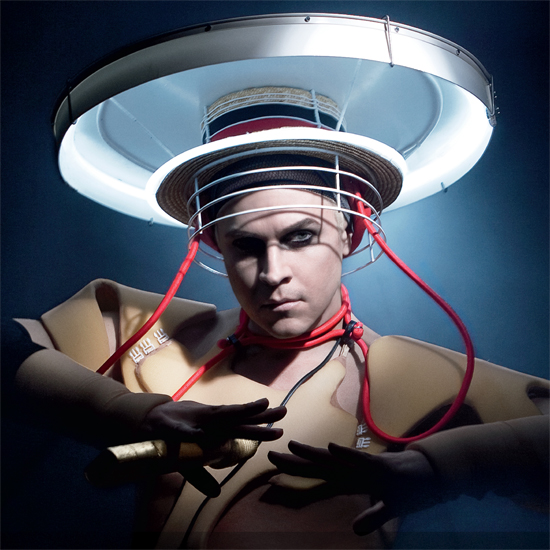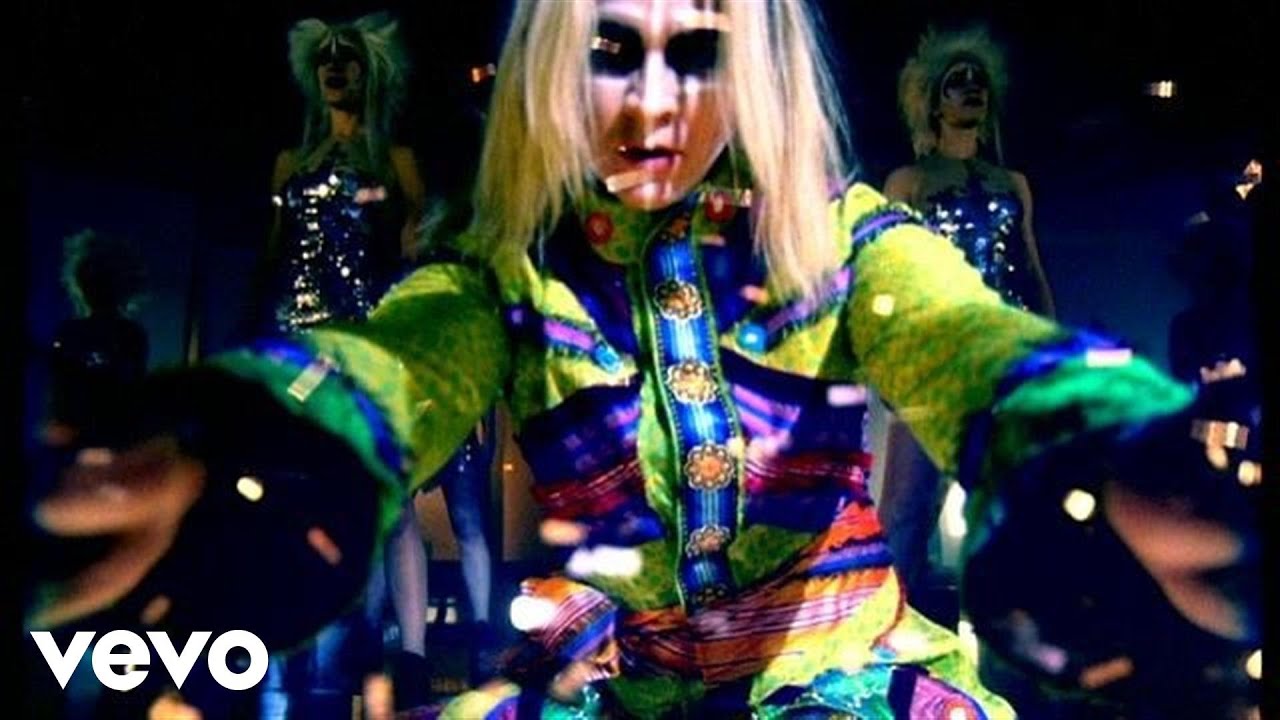I can still remember the first time I heard ‘Emerge’ by Fischerspooner. It was a Monday night at Trash, where I was a regular for much of the early years of the past decade. From what I recall, DJ Erol Alkan had managed to get hold of The End’s lazer system, and the beams cut through the fag smoke as this warm, burbling synth built and built, a nonsensical pseudo-Teutonic lyric (now heard in much of Cold Wave) over the top, before a massive chorus kicked in. I don’t think anyone really knew what the track was – this was largely pre-blog, pre-Myspace, and most people I knew spent their hard-earned on one quid pills and going out rather than records – but it made the room erupt. ‘Emerge’ now occupies a space as both the peak and perceived nadir of the short-lived movement in electronic music that became known – and derided – as electroclash.
It was hardly surprising that for me electroclash was the entry level into electronic music, which I’d abandoned for arch guitar music aged 16. Trash began as an indie night, but one that, via a strict door policy, turned away the lager-spilling lads who usually ruined such establishments with their Liam Gallagher-ap(e)ing dancing. This open-minded, mixed crowd and the kind of exuberant decadence that goes hand in hand with the Monday night club night was the perfect incubator for the electronic music that Alkan was starting to play. It was a club where your sense of belonging opened the mind to the new music being played. The Trash ritual, cocking a snook to the notion that Monday night was for staying in, was to get dressed up, knock back a bottle of Martini, and go and dance, hard, for three or four hours, in the full knowledge that getting up at half seven following three hours sleep in order to be at one’s desk at 9am might be tricky. To my mind, it was never about hanging around preening, though when the hardcore fashionistas suddenly appeared it was a bit odd – I especially recall one top hatted chap with a cigarette in a ludicrous one foot long holder.
Yet although it was arguably that sort of thing that led to electroclash’s eventual dismissal, to attack it for its connections to fashion is to miss the point. Fashion people went to clubs like Trash, Nag Nag Nag and Our Disco, rather than the clubs going out of their way to court them. Like all scenes, electroclash was a name that was rammed across an actually rather diverse set of music, from the disco-tinges of Felix Da Housecat, the marriage-counselling-gone-wrong goth of Adult., the europop of Ladytron, the neo-industrial Terence Fixmer. These were not artists lacking in pop nous, and in fact sat brilliantly (in the clubs and on my stereo) alongside what was a golden age for the mainstream, with the Neptunes, Missy Elliot, Destiny’s Child, N.E.R.D., Outkast, Kelis, Sugababes, Justin Timberlake, and Girls Aloud all releasing tight, electronic snappers. And that’s without the more obvious crossover groups, Basement Jaxx or Daft Punk. The dialogue that permitted Missy to sit alongside Peaches, Timberlake with Fischerspooner, Kelis with Adult., is the evidence that electroclash was never about snooty elitism: it shared with the mainstream a sense of class and bumping sexuality that, over the past decade, has been eroded by the rise and rise of the telly talent show.
What also did for electroclash was not its self-ghettoisation in fashionable clubs in London. Instead, it was the gateway media – music press, radio – and its conservatism and suspicion of anything flambouyant, outré, or European. Electroclash unfortunately coincided with its antithesis: the rise of the more sellable garage rock revival, and its obsession with scruffy, blokey groups like Jet, The Vines, The D4, The Von Bondies, The Dirtbombs, The Datsuns, The Hives; and thereafter UK indie skiffle in the forms of The Libertines, The Others, The Holloways, Special Needs… the list goes, depressingly, on. With guitar music once again on the rise, there was little appetite for the occasionally daft, high camp antics of the electronic movement of the time, and it was denied the oxygen tent of mainstream coverage.
It might seem strange now, but before electroclash clubbing was largely divided down genre lines. It was one of the things that broke down those boundaries. Unfortunately, this probably also led to an excess, post-Soulwax, of the habit for creating mashups of any old tunes – a brilliant idea when deployed tactically and sparingly mid-set, but bracingly naff when overdone. I remember seeing a flier for – I think – a Club Mashup in New York that featured a list of all the randomly bashed together tracks you could expect at the night.
It’s a shame that there hasn’t really been anything of electroclash’s ilk since. The bloghouse movement that followed electroclash forwent glamour in favour of simplistic drug monkey electro tweaking, while for all its brilliance you could hardly call dubstep flamboyant. As filesharing has proliferated, clubbing as form of musical discovery has declined, and genre-hopping nights have become overly neophilic and far less artfully curated. There is one group, though, who have mined the best of electronic music’s history for a glorious mince through glamorous pop, and that’s Azari & III, whose debut album will surely be towards the top of the Quietus Best Of 2011 poll. Going to see them live recently was reminiscent of those great nights out of ten years ago, a room with an even gender balance, well-dressed men and women, gay and straight, a fair few off their rockers and, most crucially, all dancing. Having said all that, anyone who wears their sunglasses at night is a prodigious bellend.
Luke’s Fruity Favourites: 10 Electroclash Bangers
Fischerspooner – ‘Emerge’
Depending on who you ask, Electroclash’s high or low point. Despite some enjoyably grand statements, a sublime cover of Wire’s ‘The 15th’ and ludicrous live performances, Fischerspooner were a flop. Nevertheless, they retained a terrific sense of humour. I remember seeing them at a Norwegian festival in the middle 00s, playing to a rain-drenched crowd who had gathered in anticipation of the night’s next set, from bafflingly successful cardigan folkster Erlend Øyé. Fischerspooner’s awareness at the plummeting of their own stock was rather commendable, with cries of "hello Olso" echoing across the baffled Scandinavian multitudes.
Felix Da Housecat – ‘Madame Hollywood’
Felix Da Housecat not only managed to create one of the bangers of electroclash with this sublime track but, in Kittenz and Thee Glitz released its best, most coherent long-player. Lyrically it dealt with the electroclash staples of fame, limousines and magazines that cost more than a tenner, but also packed a harder punch.
Golden Boy with Miss Kittin – ‘Rippin Kittin’
Another of electroclash’s plus points was the number of female artists who were at its fore. Principle among these was Miss Kittin, who turned up on vocals with Felix Da Housecat, The Hacker and this pulsing, nocturnal and mournful collaboration with Golden Boy.
Adult. – ‘Hand To Phone’
To my mind, Adult. were always engaged in a brilliant subversion of gender roles in electronic music. In their hands, the female vocalist was not fitting the accepted roles of the coquette or sultry diva in front of man-made music. Instead, Nicola Kuperus seemed to wear the trousers. And, possibly, a strap-on. Kink and electroclash were never far apart.
Soulwax – ‘NY Excuse’
Already famed for their As Heard on Radio Soulwax Pt. 2 mix album, the arrival of Soulwax’s joyful belter ‘NY Excuse’ was even more exciting than that Trash debut of Fischerspooner’s ‘Emerge’.
Tiga & Zyntherius – ‘Sunglasses At Night’
One of the bigger tracks of the time, with lyrical subject matter that became something of a stick to beat electroclash with.
Miss Kittin & The Hacker – ‘Frank Sinatra’
Again, one of those tracks that explored a world of right nostril nose bleeds and farting around: "in limosines we have sex / ever night we have friends / nice / suck my dick / so nice / Fronk, Fronk Sinatra / suck my dick / lick my ass". Who ever said electroclash didn’t have a sense of humour?
Ladytron – ‘Discotraxx’
Ladytron, with their biology degrees and Kraftwerkian aesthetic, were an altogether classier proposition, and ‘Discotraxx’, from the 604 album, is pure TV tower-through-the-mist, sinister policemen in 1983 brilliance.
Peaches – ‘AA XXX’
Another of the great albums of the time was Peaches’ debut The Teaches Of Peaches. Again, it pulled off the trick of combining sex, dry humour, and high camp with fierce, simple electronic backing. Peaches was a superb live performer too, and I well remember an early, intimate gig where she whipped the crowd into such a state things became rather… frisky all round.
Add N to (X) – ‘Plug Me In’
Although electroclash was big in the UK’s Metropolitan nightspots, there were few artists who actually hailed from the country. Ladytron were Liverpool based, and Add N to (X) flew the London flag, though they were arguably more on the fringes of the movement. Still, as ‘Plug Me In’ ably demonstrates, they were partial to wheezing synths and the saucy.
Terence Fixmer – ‘Body Pressure’
Appearing on DJ Hell’s International DeeJay Gigolos CD Five compilation that was seen by many as the key LP of electroclash, this pounder links the genre with the sterner sounds of EBM and techno. Mr Fixmer is still active, making excellent sonic grot with Nitzer Ebb’s Douglas McCarthy.





